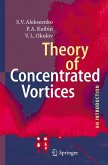Vortex motion is one of the basic states of a flowing continuum. Intere- ingly, in many cases vorticity is space-localized, generating concentrated vortices. Vortex filaments having extremely diverse dynamics are the most characteristic examples of such vortices. Notable examples, in particular, include such phenomena as self-inducted motion, various instabilities, wave generation, and vortex breakdown. These effects are typically ma- fested as a spiral (or helical) configuration of a vortex axis. Many publications in the field of hydrodynamics are focused on vortex motion and vortex effects. Only a few books are devoted entirely to v- tices, and even fewer to concentrated vortices. This work aims to highlight the key problems of vortex formation and behavior. The experimental - servations of the authors, the impressive visualizations of concentrated vortices (including helical and spiral) and pictures of vortex breakdown primarily motivated the authors to begin this work. Later,the approach based on the helical symmetry of swirl flows was developed, allowing the authors to deduce simplified mathematical models and to describe many vortex phenomena. The major portion of this book consists of theoretical studies of vortex dynamics. The final chapter presents detailed results of experimentally observed concentrated vortices that provide the basis for analysis and stimulate development of vortex theory. The mathematical description of the dynamics of concentrated vortices is hindered by the requirement to consider three-dimensional and nonlinear effects, singularity, and various instabilities. For each particular problem, very different coordinate frames and equation systems must be used.
From the reviews: "The book contains a comprehensive overview and authoritative coverage of the wide field of concentrated vortices observed in nature and technique. It familiarizes readers with the methods for research of their kinematics and dynamics. ... this book also covers recent achievements in the fields of stability analysis, waves on vortices and vortex breakdown. Scientists working in the areas of applied mathematics, and in theoretical and/or computational fluid dynamics will benefit from this book, which may serve both as a reference monograph and a textbook." (Felix Kaplanski, Zentralblatt MATH, Vol. 1132 (10), 2008)








